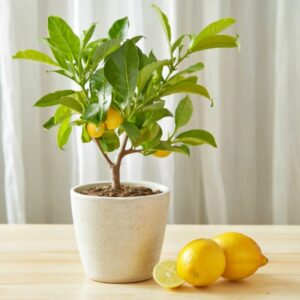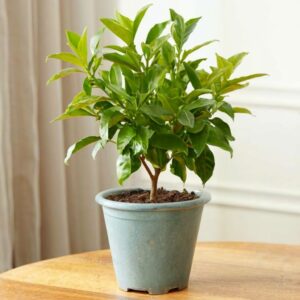Indoor gardening offers a multitude of benefits, from enhancing air quality to uplifting your home’s aesthetics. Among the various plants you can grow indoors, lemon trees stand out for their fragrant blossoms and the delight of harvesting your own fresh citrus. This guide will walk you through the process of growing a lemon tree indoors, covering everything from seeding to harvest.
Choosing the Right Variety
When it comes to growing lemon trees indoors, not all varieties are created equal. Dwarf varieties such as the Meyer lemon are ideal for indoor cultivation due to their manageable size and adaptability to container living. The Meyer lemon is particularly favored for its sweeter, less acidic fruit compared to its conventional counterparts.

Starting from Seed
Growing a lemon tree from seed can be a rewarding endeavor, albeit a test of patience. To start, choose a healthy lemon and extract its seeds. Plant the seeds in a small pot with well-draining soil, ensuring they’re moist but not waterlogged. Place the pot in a warm, sunny spot – lemon trees thrive in at least 6-8 hours of sunlight daily.

Potting and Soil
Once your seedlings emerge, repot them into a larger container with ample room for root growth. A pot with drainage holes is a must to prevent waterlogging. Use a soil mix specifically formulated for citrus trees, as this will ensure the right balance of nutrients and drainage.

Watering and Humidity
Consistent watering is key to a healthy indoor lemon tree. The soil should be kept slightly moist, but be careful not to overwater. Overly soggy soil can lead to root rot, a common issue with indoor citrus. Additionally, maintaining a humid environment is beneficial, especially in drier climates. This can be achieved through regular misting or by placing a humidity tray beneath the pot.

Fertilizing
Lemon trees are heavy feeders and require regular fertilization, especially during their growing seasons (spring and summer). Use a balanced, slow-release fertilizer formulated for citrus trees, applying it as directed on the product label.
Pruning and Maintenance
Pruning is essential for maintaining the shape and health of your lemon tree. Remove any dead or damaged branches, and prune to encourage airflow and light penetration within the canopy. This not only keeps your tree looking tidy but also helps prevent disease.
Pest and Disease Control
Keep an eye out for common pests like aphids, spider mites, and scale insects. Regularly inspecting your tree and using natural or recommended pesticides can help keep these pests at bay. Also, be vigilant for signs of disease, such as leaf drop or discoloration.

Fruit Production Timeline
One of the most common questions from indoor lemon tree growers is, “How long until I see fruit?” Patience is crucial here. When grown from seed, a lemon tree can take anywhere from 3 to 6 years to mature and produce fruit. However, trees purchased from nurseries or grown from cuttings may bear fruit sooner, typically within 2 to 3 years.

Conclusion
Growing a lemon tree indoors is a fulfilling project that brightens your living space and offers the sweet reward of home-grown citrus. With proper care and a bit of patience, you’ll enjoy the unique pleasure of plucking fresh lemons right from your living room.
